#techno arcanist stories
Explore tagged Tumblr posts
Text
WAR NEVER CHANGES. BUT,
WARFARE NEVER STOPS CHANGING
"I've seen countless reasons why most mech pilots don't make the cut, but one of the largest hurdles are the physical alterations. The implants and modifications done to the fleshware is so extreme that it's enough to push most would-be pilots away from day 1.
Back in the day, when mech tech was still in its wild west years, when the technology was still in its infancy, things were different. Levers, joysticks, switches, a chair, most of the first models were something between the cockpit of a construction vehicle and a fighter ship.
Pilots in those days still consisted largely of the usual suspects. Test pilots, army jocks, space force veterans looking for something new, the occasional crazy who lucked their way up the ranks. All you needed back then was to be fit enough to work complex machinery. 'Handler's wouldn't be a coined phrase for nearly a decade. I still remember being a kid and seeing repurposed older models in the mech fighting streams.
Everything changed with the Bidirectional Cerebellum Computer Interface. To say nothing of how it changed civilian life, it was a military marvel. The BiCCI saw the creation of Mechs as we understand them today. The first generation were just retrofits, older models with a pilot's chair, and even manual controls to use in an emergency, but even then we knew that was only temporary. Before long, sleek frames of sharp angles, railguns and plasma cannons were rolling off the factory floor.
Like many things, it began small, optimising first for cockpit space by removing the manual controls. Before long, my then-supervisors thought, "Why have this glass? Why not hook the pilot's eyesight right into the advanced multi-spectral camera system? Before long, cockpits were but soft harnesses made to house a living body, their very soul wired into the machinery. Obviously, for security reasons, I cannot tell you everything about how our latest cockpits work, but suffice to say we've been further blurring the line between pilot and frame ever since.
This drew a very different crowd. Out were the army jocks and powerlifters. The only ones who even dared to have the interface hardware installed into their brainstem and spinal cord were the dispossessed, the misanthropes, those who sought not to control their new body, but to be controlled by it. No AI can work a mech properly on its own, but our pilots are never really in full control either anymore. Those who do try to go against the symbiosis get a nosebleed at best, and vegetative seizures at worst.
And that was that. The only people left who pilots these things are those who had already been broken, those who sougt a permenant reprive from being anything resembling human. A lot of my department quit around this time. I've lost a few friends over it, I'm not shy to say. Did we knew we'd be bringing in the more vulnerable people? Of course we did. But, the wheels of progress must turn, as they say, and it wasn't like we were shy of volunteers.
In our latest models, we have refined an even more advanced frame. Again, security detail prevents me from divulging too much, but one breakthrough we've made is decreasing action latency by approximately 0.02s by amputating the limbs from our pilots and replacing them with neural interface pads.
Using the pads where the limbs once were, pilots are screwed directly into the cockpit, which itself can now be 30% smaller thanks to the saved space. And, of course, we provide basic humanoid cybernetics as part of their employment contract while they are with us. Not that most of them are ever voluntarily out of their cockpits long enough to make use of them. Even removing the tubes from their orifices for routine cleaning incurs a large level of resistence.
And, yes, some of them scream, some of them break, some become so catatonic that they might as well be a peripheral processor for their mech's AI. But not a single one, not even one pilot, in all the dolls i've ever trained, have ever accepted the holidays we offer, the retirement packages, the stipends.
As you say, there are those who like to call me a monster for my work. I can see why. After all, they don't see the way my pilots' crotches dribble when I tell them I'll be cutting away their limbs, or the little moans they try to hide when we first meet and I explain that they'd forever be on the same resource level as a machine hereafter.
Those who call me a monster don't realise that, even after going public with how we operate our pilots, even after ramping up mech frame production, we still have more than twice as many volunteers as frames.
Those who call me a monster cannot accept that my pilots are far happier as a piece of meat in a machine of death than as the shell of a human they once were.
Those who call me a monster never consider the world my pilots grew up in to make them suitable candidates in the first place."
-Dr Francine Heathwich EngD
Dept. Cybernetic Technologies @ Dynaframe Industries
[In response to human rights violations accusations levied by the Pilot Rehabilitation Foundation]
#mechagirlposting#mechposting#mecha#empty spaces#techno arcanist stories#mechanophilia#horror#short story#creative writing#writing#writing on tumblr#mech pilot#dollposting
361 notes
·
View notes
Text
Fabula Ultima: High Fantasy Atlas Review
Emmy award winning TTJRPG, Fabula Ultima, just released its first sourcebook in English! The High Fantasy Atlas is already a best Electrum seller on DriveThruRPG and at the time of writing, the best selling book on the platform this week... all within one day! But, if that hasn't convinced you, let me offer you my review.
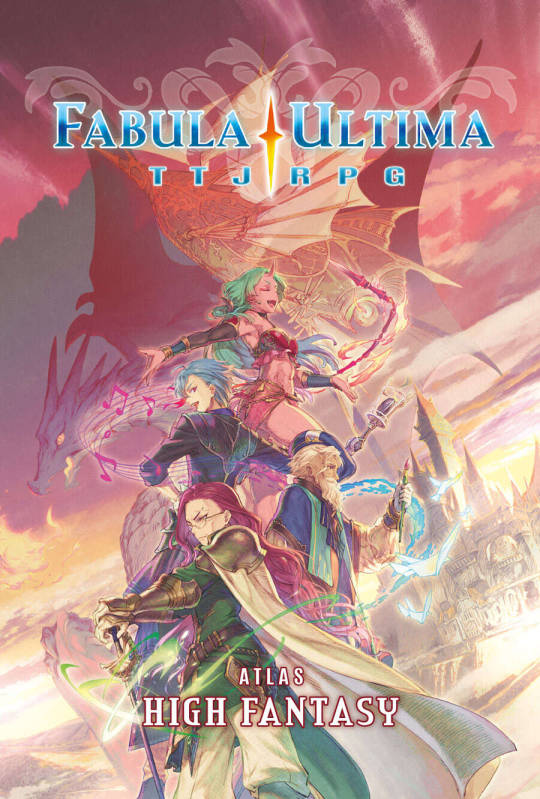
What do you get in the High Fantasy Atlas? Well you'll find the following:
Chapter 1 - Introduction: This section covers how the pillars of JRPGs work in High Fantasy games and offers more details and examples on how to implement them. Very useful for session 0 world design.
Chapter 2 - The World: This introduces 10 sample high fantasy locations you're likely to explore in a high fantasy world of Fabula Ultima game along with advice for creating new Arcanum for the Arcanist class, details concerning the creation of gods and demons, how the Stream of Souls functions, and info on tech and magic. The latter part of the chapter has new rare item rewards and artifacts you can give players!
Chapter 3 - Protagonists: This chapter includes sample PC ideas with info on them along with the new custom weapon, quirk, and zero power optional rules. The latter part of the chapter includes 4 new classes, the chanter, commander, dancer, and symbolist, along with heroic skills for classes new and old.
Chapter 4 - Antagonists: The first part of this chapter explores how to use antagonists in High Fantasy games while the latter half offers 5 villains from levels 10 - 60 you can use in your game or as a jumping off point to make your own!
Overall, 200 pages of content useful for not just High Fantasy games, but any really! Let's go over some of my favorite bits in each chapter.
Chapter 1: Introduction
This chapter, though the shortest, is incredibly helpful. Having examples and additional explanation for how to implement the pillars is useful for groups, especially those coming from systems like D&D and Pathfinder who might not be used to having such power to shape the world. Otherwise, it offers a solid introduction to the genre as well.
Chapter 2: The World
By far the longest chapter, there's a few notable things that aid immensely, but let us begin with how the sample locations work.
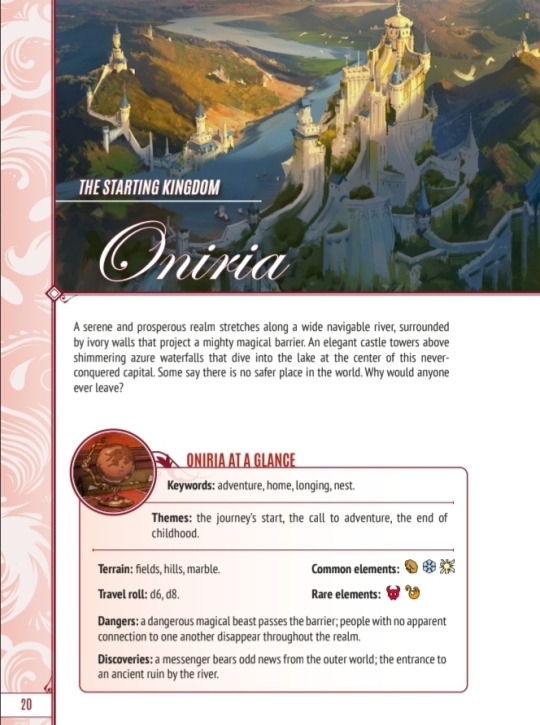
Each of the 10 locations starts off like this with an intro and an "at a glance" sidebar. This really helps you conceptualize what the area is supposed to invoke feelings wise and offers you nice reference for travel rolls and what kind of enemies and discoveries you may find here. I highly recommend doing this for locations in general your group makes, it helps a ton.
After this, each location has some example quests and questions to ask your players to flesh out this area and areas like it. Perfect for giving others the ability to add their own flair to the area and to get them started with playing when they enter the area. These story hooks also often have a villain described with tactics they use and any relevant clocks, but they have no stat blocks, so you can make them to fit with your group's playstyle for combats.
Afterward is a section on how to run conflicts and make them memorable, helpful if that is something you've been struggling with. It also has some nice ideas regarding how to run fights against armies, which is certain to come up here and there in games.
Lastly, we explore the magic and tech of High Fantasy. The advice for making new Arcanum, whether for world building themes or for the Revelation heroic skill, is greatly appreciated as it's one of the hardest things to balance and get right without a good understanding of the game. Advice on how the afterlife and Stream of Souls works thematically in your game is also useful and it offers some nice plot hooks you can use with the ideas presented I've put into practice even before the release of the Atlas to great effect. Lastly, the section on technology is short but appreciated, exploring how it differs from a Techno Fantasy game.
The new rare items are mostly geared towards enhancing specific skills for classes rather than general use, but it's handy for figuring out how to price similar items focused on certain skills when making your own. The new artifacts are also grandiose and powerful additions to any game, magnificent rewards if your party can acquire them. My favorite is a book that contains all knowledge up to the present moment in time, but was sealed away in the far reaches of space... supposedly.
Chapter 3: Protagonists
The main course! This has the 4 new classes and a bunch of optional rules we saw in the playtest. But, first I want to take a look at the sample PCs.
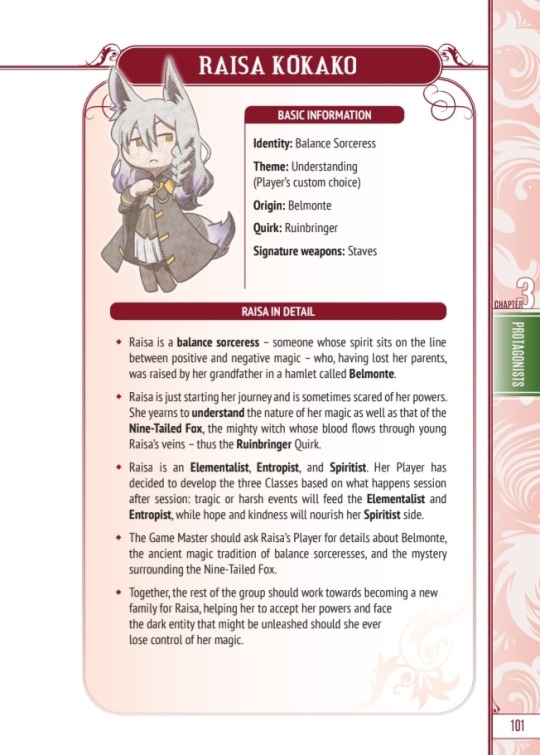
Each of the 10 sample PCs has a profile like such. It covers the usual Identity, Theme, and Origin, along with a Quirk and signature weapon. Quirks are a new rule that work as backgrounds, but suped up with powerful game changing and character altering effects ranging from gaining some spells to being able to choose to make costs for a spell or Ritual free at the cost of eventually summoning a supreme villain... that will come eventually whether you like it or not. Ones like those typically give you a free heroic skill when the big event comes and you lose the quirk. Preparing you to face a new horizon or final foe.
Back to Raisa however. As we can see here, it has info on her backstory, classes, what she gets to decide about world building wise, and how they'll grow in their own character arc. Useful for someone who wants to jump right in with a somewhat premade character, but even more useful for showing your players what you need to know about their characters if you're a GM. This should also help direct and inspire players during world creation. Which I greatly appreciate. Now, for the new optional rules (besides quirks).
Custom weapons are pretty simple. They're essentially weapons you design mechanically as a player. They're always two-handed, cost 300 - 400 zenit, can be any weapon type you want along with being melee or ranged, and deals [HR + 5] physical damage with a [DEX] + [INS/MIG] accuracy check depending on what you choose. You can then pick a few traits, like Powerful for extra damage, Defense Boost for extra armor and to make it count as a shield, or Transforming to let it switch between two different modes. Depending on what traits you pick, it may also become martial. This rule can be used by anyone who wants to use it without fuss unlike quirks and zero powers, as it adds no extra power and is fairly balanced. Some people could play with custom weapons, some without. But, it allows for you to add a lot of style to your character if you choose to do so.
Lastly, zero powers are a mechanic I've been using for half a year from the playtest and it's loads of fun! Want a limit break or perhaps combo attack in vein of Tales of Arise? Zero powers have you covered. When using this rule, you gain a 6 point clock that fills whenever taking damage, spending a Fabula Point to invoke a trait or bond, or via special Zero Trigger you pick when making your power. Then you pick an effect to go with the trigger you can unleash with an action when the clock is full, like Zero Limits which boosts all your stats by 1 die size or Zero Triangle to allow you and 2 allies to make a free attack with a +5 bonus to accuracy. Zero Powers are loads of fun and you can even allow for players to charge them up together for combo attacks with a variant rule for 4 or less player parties.

Welcome to the show! The Chanter is your premier bard. Chanter's main skill is Magichant, which allows them to sing or play songs you compose yourself by picking a volume (to determine number of targets), key (to determine damage types, attribute, status effect, HP/MP), and tone (to determine the effect with info filled in by your key). It's an amazing support class with high MP usage, but they can easily target enemy Vulnerabilities or act as a debuffer too to tear their foes apart. Their other skills allow them to perform hearing-based illusion Rituals, increase damage or regain MP when enemies are hit, give damage reduction to themselves, or get a free attack with low and medium volume magichants.
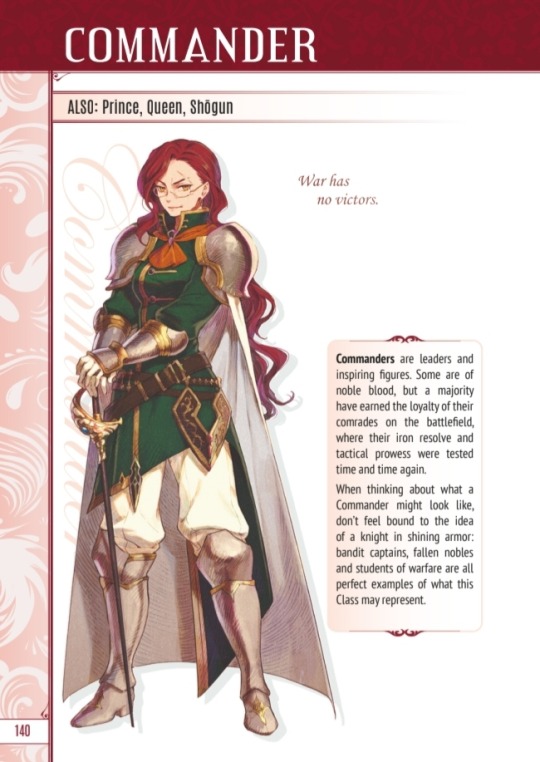
Being a chess master is the name of the game with Commander. Gaining access to martial weapons of all types, the Commander has skills focused on creating conflict scene wide buffs and debuffs to everyone. Use Bishop's Edict to double MP costs or increase all damage or King's Castle to increase HP/MP recovery or null it entirely. Their other skills allow them to command allies to make free attacks with handy bonuses and chain together their skills when doing so, leading to a flurry of activations. But be careful, one wrong move can lead to your downfall. Commander works best as a sort of Warlord class, they're a support martial pure and simple, but if the player using it isn't very smart about how they use their skills they can put everyone in a heap of trouble.

Swift of step, Dancer's main skill is well... Dance! Dance allows you to spend 10 MP before or after an action to perform a dance (5 MP if you used Dance last turn). Dances provide a variety of effects but most give you resistance to a damage type or allow you to alter all your damage to that type until the end of the turn or give the enemy a status condition, or another different one if they already have it. There's also healing and haste dances if you want those too! Their other skills allow them to apply dances to others they have affection towards, dance and use the equipment action for free, get bonuses towards rolls involving acrobatics for Objectives, or increase the damage of their weapons or spells after dancing. Dancer is primarily another support class, but their ability to change damage types and increase damage makes them amazing at targeting Vulnerabilities and denying enemies damage by gaining Resistance.
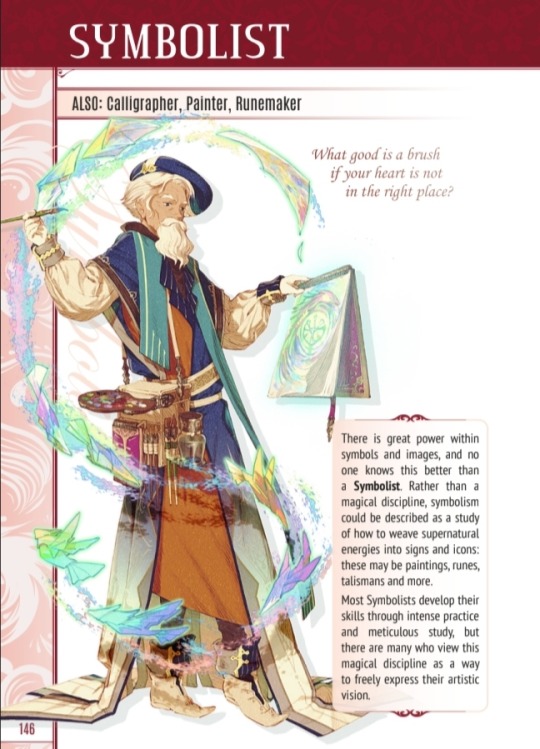
Symbolism has always been the heart of magic and the Symbolist knows this best. An IP focused class like Tinkerer, Symbolist's main skill is Symbolism. By spending 2 IP, you can create a symbol and attach it to an ally or make a free attack and apply it to every enemy you hit (amazing with multi). Symbols range in effect from halving recovery, providing one free IP expenditure, or even changing the creature type. Their other skills allow allies with a symbol cast your spells, make sight-based illusions with Rituals, track enemies with symbols, and increase damage or recovery on those with your symbols. The Symbolist, like the Tinkerer, is focused on IP usage and as such will need a class like Rogue, Merchant, or Wayfarer to help keep that up. However, symbols allow for a lot of strategy and creativity in character building that you can use to your benefit. Picking your symbols will be paramount to your build, so be smart about what you pick and smarter about who you apply them too. Sharpshooter and Weaponmaster are also great picks if you intend to apply symbols to enemies.
Lastly, the new heroic skills are all solid. Most focus on using specific types of weapons, now rewarding you for sticking to them as your signature weapon. There's even a few only available to level 30 and higher, notably, Bimagus, which let's you dualcast spells and Grand Summon, which allows you summon Arcanum as separate entities to help you rather than merging.
Chapter 4: Antagonists
Compared to the last two chapters, there's less to say here but there is some great content. This chapter includes 5 villains of levels 10, 20, 30, 40, and 60 that make for fun inclusions in any High Fantasy game. The villains range from a pirate queen to the incarnation of narrative tragedy itself and each comes with a statblock, minions (if they have any), and advice on how to run their encounters. Some even have multiple phases, which is a great example of how to build your own multi-phase boss fights, after all... this isn't even their final form!
One thing to remember when using these enemies (and the book points this out thankfully) is that Fabula Ultima is designed in a way where you, the GM, have to make monsters your party can reflect upon and has the tools to fight effectively. So, when using these, change up the affinities, give them a makeover to connect to the heroes if needed, and use them as you see fit!
Final Thoughts
If you have been loving Fabula Ultima, pick up this book. There's so much great advice for running games and new content for players and GMs alike. You won't be disappointed! There's also some more beautiful JRPG style art within just like the Core Rulebook. If you enjoyed Bravely Default, FFIV, FFIX, FFX, or Tales of Arise, this book will let you live out the same fantasies and journeys featured in those games and gives you even more tools to be your very own heroes of High Fantasy and challenge tragedy itself on the Final Days.
You can purchase it on DriveThruRPG for $14 USD ($20 CDN).
59 notes
·
View notes
Text
Hack Capacitor Technomancer (Technomancer Alternate Class Feature)

(art by EvgeniaKurai on DeviantArt)
In many ways, the technomancer of Starfinder is something of the distant descendant of the arcanist from First Edition Pathfinder. They get all sorts of ways to fiddle with their spells and technology to make themselves more and more flexible.
One of the ways that the vanilla technomancer does so is their cache capacitor, which allows them to store and perpetuate the energy of a single spell, letting them benefit from it all day. These can be anything from constant buffs, supporting magic, or even the ability to cast certain blasting spells all day.
However, not every technomancer finds that to be useful for them. Some instead use their capacitors to store arcane formulae that are integral to their various hacks. In other words, these mages gain some flexibility with their techniques instead.
I feel like some will have a hard time justifying how this option works depending on how they flavor their magical hacks. If they are just something that the character knows how to do, it might be hard to reconcile having flexible hacks unless they flavor it as improvisations, while others might set up complex mystical theorems in their cache which they can tap into in an emergency.
In any case, these mystics can prove surprisingly versatile, as we shall soon see.
These technomancers select three magical hacks that they don’t already have, which they can change out as they grow stronger. With a bit of effort they can briefly gain one of these hacks as needed. Doing so for the first time is free, but doing so repeatedly throughout the day drains their reserves. As they grow in power, they deepen their pool of potential abilities and are even able to manifest multiple at once for the cost of more resolve.
While it is fairly simple, this ability set is quite useful as you are effectively gaining three, then four and five extra magical hacks, at the cost of draining your resolve points to use them. I would recommend selecting a wide variety of hacks to suit different situations, which may change as you level up, changing up the capacitor hacks or even taking some as permanent additions. Also consider that you could use the capacitor to gain more powerful improvements of hacks you already have, should they exist.
The interesting thing about technomancy is that, despite having heavy roots in the arcane magic of old, the path that an individual technomancer takes to get where they are likely extremely personal and a question of what works for the caster, which I imagine makes viewing someone else’s technomagical devices and spells very much like someone’s homebrew wiring or coding: equal parts horrifying and awe-inspiring in how it all fits together and works. As such, I don’t think most technomancers would even notice a difference between those with a normal cache capacitor and those with a hack capacitor until they see them in action, and even then, it is simply a quirk of their process.
They say that Akvus’s technomagical capacitor, a cybernetic hand with an arcane supercomputer built in, was capable of reshaping magic in incredible ways. As such, many modern technomancers desire the relic, some for the power it could grant, and others simply to study it. Of course, the last time it was seen was plummeting into a rift to some far-off plane.
They say that Binbi Firestep always has a new trick up her sleeve, and the halfling technomancer certainly lends truth to the stories. However, all of those tricks will be put to the test when her many enemies come together to try and bring her down… but perhaps the party can interfere?
Young technomancers are often eager to explore the limits of magic, technology, and the blending of the two. Perhaps that is why so many signed up for the tutoring of Blackmaw, a notorious techno-necromancer. Now, most of these students are reanimated as cybernetic zombies after he was done experimenting on them, while he bears the fruits of their innovations.
#starfinder#alternate class feature#technomancer#hack capacitor technomancer#halfling#cybernetic zombie#Character Operations Manual
14 notes
·
View notes
Text
Goldliet!au Characters
Characters for my dream smp D&D au!
Tommy: Tommy is an Ifriti Fighter and the main character along with Wilbur, Tubbo, Karl and Niki! For those who don’t know: Ifrits are humans with fire elemental ancestry- basically people but add some fire.
Tubbo: Tubbo is a Gathlain Alchemist- a chirurgeon to be a little more specific! For those who don’t know: Gathlains are like large wooden pixies. They’re about the same size as halflings and have wings of wood and plant. Chirurgeons are a healing subtype of Alchemists and tend to have more support based pots than other alchemists.
Wilbur: Wil is a Fetchling-Ifrit hybrid Bard. For those who don’t know: Fetchlings are decedents of humans trapped in the shadow plane, and look similar to humans, but their complexions and hair are drained of color and range from stark white to pitch black.
Niki: Niki is a Changeling Cleric. For those who don’t know: Changelings (The kind I based Niki off of) Are the offspring of hags and are often abandoned at doorsteps to be taken into foster care. They are always born female.
Karl: Karl is a Sylph Ranger. For those who don’t know: Sylphs are basically the same as Ifrits, but instead of fire, they’re air.
Dream: Dream is a Vishkanya Slayer. For those who don’t know: Vishkanya are exotic humanoids with poisonous blood and serpentine eyes and forked tongues. they’re described as having alien beauty though, so take that as you will. Slayers are a cross between rangers and rouges.
George: George is a Gnome Sorcerer. :)
Sapnap: Sapnap is a Human Barbarian. :)
Philza: Phil is a Suli Magus. For those who don’t know: Suli’s are like genie children. kind of... Strong and attractive, these dynamic individuals can call forth elemental energies to augment their prowess in combat. Neither genie nor quite human, sulis stand in two worlds and often feel as if they don’t belong to either. Magus are a cross between fighters and sorcerers.
Techno: Techno is a cursed Human Magus-Monk multi-classer. I decided to make Techno a “cursed” human, meaning that he has a curse that gave him boar-like features as punishment for something, but instead Techno took a liking to the curse.
Bad: Bad is a Drow Paladin. For those who don’t know: Drow are basically dark elves.
Skeppy: Skeppy is an Half-elf Rouge. :)
Fundy: Fundy is a Huldra Barbarian. For those who don’t know: Huldra are humanoid fae that look completely human save for their fox tails and the gaping hole in their backs- showing that they are basically hollow, despite this they are quite a bit stronger than they look.
Eret: Eret is an Aasimar-Tiefling hybrid Rouge. For those who don’t know: Tieflings are the offspring of a fiend or demon with any other race and have many demonic traits that very from tiefling to tiefling. Aasimars are the opposite of this, being holy offspring.
Quackity: Big Q is an Aarakocra Ranger. For those who don’t know: Aarakocras are bird people.
Schlatt: Schlatt is a Satyr Swashbuckler. :)
Scott Smajor: Scott is a Munavri Arcanist. For those who don’t know: Munavri are humans who have milky white skin and lavender or pink eyes. Munavris are telepathic with others of their kind and rarely speak aloud among one another, and possess an uncanny ability to use and understand nearly every object they handle. Arcanists are a mix of sorcerers and wizards, combining their arcane powers.
There are others too, but these characters are the most prominent in the context of the story.
If you have any questions about what someone’s race/class is, or have any questions about the Au in general, I encourage you to ask! :)
#mcyt#tommyinnit#tubbo#wilbur soot#niki nihachu#karl jacobs#dreamwastaken#georgenotfound#sapnap#philza#technoblade#badboyhalo#skeppy#fundy#eret#quackity#jschlatt#scott smajor#goldliet!au#holy fucking shit this was so much to write in one night#worth it though I'm excited as fuck#I got tired half way through you can tell cause I started copy/pasting race descriptions ;-;#anyway I really hope y'all enjoy this au- please reblog it it would mean the world to me if you did!!#Thanks :)
34 notes
·
View notes